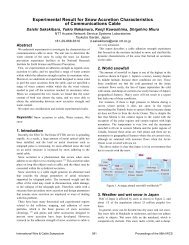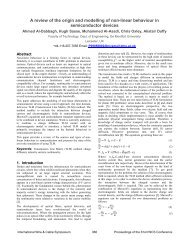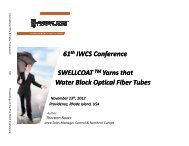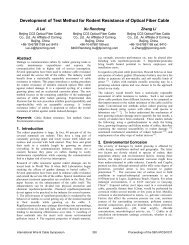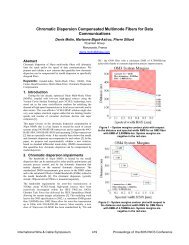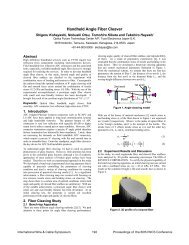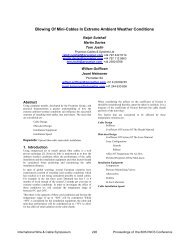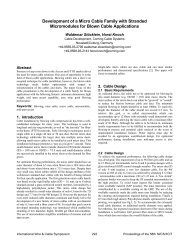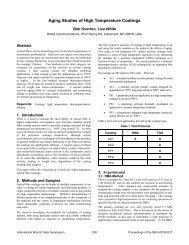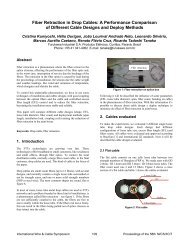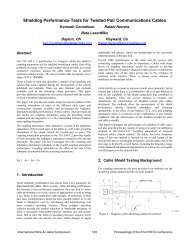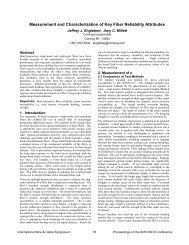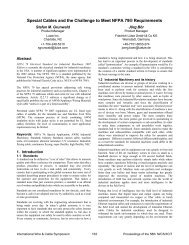Development of High Temperature Fiber and ETFE Tight Buffered ...
Development of High Temperature Fiber and ETFE Tight Buffered ...
Development of High Temperature Fiber and ETFE Tight Buffered ...
Create successful ePaper yourself
Turn your PDF publications into a flip-book with our unique Google optimized e-Paper software.
<strong>Development</strong> <strong>of</strong> <strong>High</strong> <strong>Temperature</strong> <strong>Fiber</strong> <strong>and</strong> <strong>ETFE</strong> <strong>Tight</strong> <strong>Buffered</strong> <strong>Fiber</strong><br />
Zhixiong Sun Zhuang Xiong Dingfang Xu Zheng Xu Bing Wan<br />
Yangtze Optical <strong>Fiber</strong> <strong>and</strong> Cable Co. Ltd.<br />
Wuhan, Hubei, P. R. China<br />
+86-27-67887644 · sunzhixiong@y<strong>of</strong>c.com<br />
Abstract<br />
The fibers used in some specific fields such as aeronautics <strong>and</strong><br />
astronautics, should work under the circumstances with the<br />
temperature range from -60°C to +150°C. Ordinary fibers with<br />
normal UV cured acrylate coating can not meet the dem<strong>and</strong>. Thus, a<br />
high temperature fiber <strong>and</strong> corresponding <strong>ETFE</strong> tight buffered fiber<br />
are developed. In this paper, the structure <strong>of</strong> <strong>ETFE</strong> tight buffered<br />
fiber is presented. In addition, a lot <strong>of</strong> performance tests including<br />
thermal shock test, temperature cycling test <strong>and</strong> ageing test are<br />
carried out to verify the reliability <strong>of</strong> the products. The results <strong>of</strong><br />
these tests are also introduced in the paper.<br />
Keywords: <strong>High</strong> temperature fiber; <strong>Tight</strong> buffered fiber; <strong>ETFE</strong>,<br />
Thermal shock test; <strong>Temperature</strong> cycling test; Ageing test<br />
1. Introduction<br />
The coating, physically in contact with the fiber, will greatly<br />
affect the optical performance <strong>of</strong> the fiber. The operational<br />
temperature <strong>of</strong> silica fiber depends on what kind <strong>of</strong> coating it<br />
comprises. Such temperature <strong>of</strong> the fiber with normal UV cured<br />
acrylate coating ranges from -60°C to +85°C. However, high<br />
temperature fibers, which should be used in the environment with<br />
higher temperature, for example, 150°C, plays an important role<br />
in aeronautics <strong>and</strong> astronautics as well as military <strong>and</strong> equipment<br />
industry.<br />
Compared with normal fibers <strong>and</strong> their tight buffered structure,<br />
high temperature fibers utilize special fiber coating <strong>and</strong> polymer<br />
for tight buffer. In this paper, a high temperature fiber <strong>and</strong> its<br />
<strong>ETFE</strong> tight buffered structure are developed, which can satisfy<br />
the requirement <strong>of</strong> surrounding temperature from -60°C to<br />
+150°C. Then reliability tests are carried out on these fibers.<br />
Results <strong>of</strong> thermal shock test, temperature cycling test <strong>and</strong> ageing<br />
test are also presented in the paper. In addition, fiber strippability<br />
is tested before <strong>and</strong> after those reliability tests, but the test results<br />
will be given in another paper.<br />
2. <strong>High</strong> <strong>Temperature</strong> <strong>Fiber</strong><br />
The selection <strong>of</strong> coating is the key to the development <strong>of</strong> high<br />
temperature fibers. Table 1 shows the comparison <strong>of</strong> different<br />
coatings. The high temperature fiber product features dual coating<br />
system on 100kpsi pro<strong>of</strong>-tested fiber, including silicone layer<br />
followed by high temperature acrylate layer. Inner silicone<br />
coating is a thin layer which is bonded directly to the glass<br />
surface <strong>of</strong> an optical fiber while outer coating is high temperature<br />
acrylate, which makes the fiber up to the diameter <strong>of</strong> 250µm <strong>and</strong><br />
allows the fiber to be used in the environment with the<br />
temperature up to +150°C.<br />
Results <strong>of</strong> thermal shock test <strong>and</strong> temperature cycling test will be<br />
given later while the test conditions are shown in Table 2.<br />
Temp. Upper<br />
Limit(°C)<br />
Table 1. Comparison <strong>of</strong> different coatings<br />
Table 2. Test conditions<br />
2.1 Thermal shock test<br />
Thermal shock test simulates the environment in which<br />
temperature changes instantly from high to low <strong>and</strong> vice versa.<br />
<strong>Temperature</strong>(℃)<br />
<strong>Temperature</strong>(℃)<br />
Test Item<br />
Thermal<br />
shock test<br />
210<br />
180<br />
150<br />
120<br />
90<br />
60<br />
30<br />
0<br />
-30<br />
-60<br />
-90<br />
210<br />
180<br />
150<br />
120<br />
90<br />
60<br />
30<br />
0<br />
-30<br />
-60<br />
-90<br />
Acrylate<br />
<strong>High</strong> Temp.<br />
(°C)<br />
<strong>High</strong> Temp.<br />
Acrylate<br />
A7305109AB1(Silicone&KS2-004)-CJ-1310nm<br />
0<br />
-0.01<br />
-0.02<br />
0 2 4 6 8 10 12 14 -0.03<br />
Time(h)<br />
<strong>Temperature</strong><br />
0.05<br />
0.04<br />
0.03<br />
0.02<br />
0.01<br />
Change <strong>of</strong><br />
attenuation(dB/km)<br />
-0.04<br />
-0.05<br />
Change <strong>of</strong> attenuation<br />
Figure 1. Induced attenuation change at 1310nm in<br />
thermal shock test<br />
A7305109AB1(Silicone&KS2-004)-CJ-1550nm<br />
0<br />
-0.01<br />
-0.02<br />
0 2 4 6 8 10 12 14 -0.03<br />
Time(h)<br />
Silicone<br />
<strong>Temperature</strong><br />
Polyimide<br />
85 150 200 300<br />
Low Temp.<br />
(°C)<br />
Humidity<br />
(%)<br />
150 -60 --<br />
TCT 150 -60 55<br />
Details <strong>of</strong> Test<br />
Requirements<br />
Without tension,<br />
attenuation is measured.<br />
Then thermal shock test<br />
is carried out. Keep at<br />
both temperature<br />
extremes for 30 minutes.<br />
After that, attenuation is<br />
monitored online.<br />
3 cycles, 1°C /min,<br />
attenuation is monitored<br />
<strong>and</strong> recorded<br />
automatically.<br />
Strippability is tested<br />
after TCT.<br />
0.05<br />
0.04<br />
0.03<br />
0.02<br />
0.01<br />
Change <strong>of</strong><br />
attenuation(dB/km)<br />
-0.04<br />
-0.05<br />
Change <strong>of</strong> attenuation<br />
Figure 2. Induced attenuation change at 1550nm in<br />
thermal shock test<br />
International Wire & Cable Symposium 431 Proceedings <strong>of</strong> the 58th IWCS/IICIT
The test is used to examine the fiber’s resistance to rapid<br />
temperature changes, to determine the reliability <strong>and</strong> stability <strong>of</strong><br />
its optical performance, <strong>and</strong> to improve the product quality.<br />
Figure 1 <strong>and</strong> Figure 2 show induced attenuation changes at<br />
1310nm <strong>and</strong> 1550nm respectively during the thermal shock test.<br />
The maximum change <strong>of</strong> attenuation in the test at 1310nm<br />
wavelength is +0.008dB/km while that at 1550nm wavelength is<br />
+0.011dB/km.<br />
2.2 <strong>Temperature</strong> cycling test<br />
Figure 3 <strong>and</strong> Figure 4 show induced attenuation changes at<br />
1310nm <strong>and</strong> 1550nm during the temperature cycling test. The<br />
maximum change <strong>of</strong> attenuation in the test at 1310nm wavelength<br />
is +0.009dB/km while that at 1550nm wavelength is<br />
+0.011dB/km.<br />
<strong>Temperature</strong>(℃)<br />
<strong>Temperature</strong>(℃)<br />
A7305109AB1(Silicone&KS2-004)-TCT-1310nm<br />
210<br />
180<br />
0.05<br />
0.04<br />
150<br />
0.03<br />
120<br />
0.02<br />
90<br />
0.01<br />
60<br />
0<br />
30<br />
-0.01<br />
0<br />
-0.02<br />
-30 0 11 22 33 -0.03<br />
-60<br />
-0.04<br />
-90<br />
-0.05<br />
Time(h)<br />
<strong>Temperature</strong> Change <strong>of</strong> attenuation<br />
Figure 3. Induced attenuation change at 1310nm in<br />
temperature cycling test<br />
A7305109AB1(Silicone&KS2-004)-TCT-1550nm<br />
Change <strong>of</strong><br />
attenuation(dB/km)<br />
210<br />
180<br />
0.05<br />
0.04<br />
150<br />
0.03<br />
120<br />
0.02<br />
90<br />
0.01<br />
60<br />
0<br />
30<br />
-0.01<br />
0<br />
-0.02<br />
-30 0 11 22 33 -0.03<br />
-60<br />
-0.04<br />
-90<br />
-0.05<br />
Time(h)<br />
<strong>Temperature</strong> Change <strong>of</strong> attenuation<br />
Figure 4. Induced attenuation change at 1550nm in<br />
temperature cycling test<br />
3. <strong>ETFE</strong> <strong>Tight</strong> <strong>Buffered</strong> <strong>Fiber</strong><br />
An <strong>ETFE</strong> buffer is extruded on the fiber to 900µm in diameter, as<br />
shown in Figure 5.<br />
Figure 5. Structure <strong>of</strong> <strong>ETFE</strong> tight buffered fiber<br />
The selection <strong>of</strong> buffer polymer is very important in the<br />
development <strong>of</strong> high temperature tight buffered fibers. The<br />
coating <strong>and</strong> the buffer may be mechanically removed from the<br />
fiber in one step, which is convenient for direct termination with<br />
connectors. Mechanical stripping in short length (about 15mm) is<br />
Change <strong>of</strong><br />
attenuation(dB/km)<br />
also permitted to remove the buffer <strong>and</strong> leave the coating intact,<br />
which can facilitate the splicing with 250μm fibers from gel-filled<br />
cables with loose tube structure.<br />
In this section, the properties <strong>of</strong> <strong>ETFE</strong> resin are introduced.<br />
Thermal shock test, temperature cycling test <strong>and</strong> ageing test are<br />
performed on the tight buffered fiber. Test conditions are shown<br />
in Table 3.<br />
Table 3. Test conditions<br />
Test Item<br />
Thermal<br />
shock test<br />
<strong>High</strong> Temp.<br />
(°C)<br />
Low Temp.<br />
(°C)<br />
Humidity<br />
(%)<br />
150 -60 --<br />
TCT 150 -60 55<br />
Ageing test 150 -- --<br />
Details <strong>of</strong> Test<br />
Requirements<br />
Without tension,<br />
attenuation is measured.<br />
Then thermal shock test<br />
is carried out. Keep at<br />
both temperature<br />
extremes for 30<br />
minutes. After that,<br />
attenuation is monitored<br />
online.<br />
3 cycles, 1°C /min,<br />
attenuation is monitored<br />
<strong>and</strong> recorded<br />
automatically.<br />
Strippability is tested<br />
after TCT.<br />
Without tension,<br />
duration is 30 days.<br />
Attenuation is measured<br />
once a week.<br />
Strippability is tested<br />
after ageing test.<br />
3.1 Properties <strong>of</strong> <strong>ETFE</strong> Resin<br />
<strong>ETFE</strong> (Ethylene tetrafluoroethylene) is used for the<br />
applications requiring good impact resistance <strong>and</strong> stress cracking<br />
resistance. The resin maintains these properties even at<br />
continuous working temperature over 150°C. These features make<br />
<strong>ETFE</strong> an excellent c<strong>and</strong>idate for the materials used in chemical or<br />
mechanical industry.<br />
The main properties <strong>of</strong> <strong>ETFE</strong> are:<br />
• Excellent impact resistance;<br />
• Enhanced durability <strong>and</strong> stiffness against other fluoropolymers;<br />
• <strong>High</strong>er pressure rating than other fluoropolymers;<br />
• <strong>High</strong>er tensile strength <strong>and</strong> creep resistance than other<br />
fluoropolymers;<br />
• Better crush resistance than other fluoropolymers.<br />
Additional Properties <strong>of</strong> <strong>ETFE</strong> are:<br />
• Sterilizable by Gamma ray, ETO <strong>and</strong> e-beam;<br />
• Working temperature up to 150°C;<br />
• Chemical resistant;<br />
• Flame retardancy: UL-94 V0;<br />
• Limiting oxygen index: 30.<br />
Due to its excellent flame retardancy <strong>and</strong> good flexibility at low<br />
temperature as well as the retention <strong>of</strong> properties after ageing at<br />
elevated temperatures up to 150°C, <strong>ETFE</strong> is the best RoHS<br />
compliant polymer for fiber protection as the tight buffer. The<br />
comparison <strong>of</strong> different tight buffer materials is shown in Table 4.<br />
International Wire & Cable Symposium 432 Proceedings <strong>of</strong> the 58th IWCS/IICIT
Table 4. Comparison <strong>of</strong> different tight buffer polymers<br />
3.2 Thermal Shock Test<br />
Figure 6 <strong>and</strong> Figure 7 show induced attenuation changes at<br />
1310nm <strong>and</strong> 1550nm during the thermal shock test for <strong>ETFE</strong> tight<br />
buffered fibers.<br />
The maximum change <strong>of</strong> attenuation in the test at 1310nm<br />
wavelength is +0.016dB/km while that at 1550nm wavelength is<br />
+0.020dB/km.<br />
<strong>Temperature</strong>(℃)<br />
<strong>Temperature</strong>(℃)<br />
Material<br />
A7305109AA4(Silicone&KS2-004&<strong>ETFE</strong>900um)-CJ-1310nm<br />
210<br />
180<br />
0.05<br />
0.04<br />
150<br />
0.03<br />
120<br />
0.02<br />
90<br />
0.01<br />
60<br />
0<br />
30<br />
-0.01<br />
0<br />
-0.02<br />
-30 0 2 4 6 8 10 12 14 -0.03<br />
-60<br />
-0.04<br />
-90<br />
-0.05<br />
Time(h) <strong>Temperature</strong> Change <strong>of</strong> attenuation<br />
210<br />
180<br />
150<br />
120<br />
90<br />
60<br />
30<br />
0<br />
-30<br />
-60<br />
-90<br />
Typical<br />
Temp.<br />
Rating<br />
(°C)<br />
Flame<br />
Retardancy<br />
Figure 6. Induced attenuation change at 1310nm in<br />
thermal shock test<br />
A7305109AA4(Silicone&KS2-004&<strong>ETFE</strong>900um)-CJ-1550nm<br />
-0.02<br />
0 2 4 6 8 10 12 14 -0.03<br />
Time(h)<br />
Limiting<br />
Oxygen<br />
Index<br />
(LOI)<br />
Abrasion<br />
Resistance<br />
<strong>Temperature</strong><br />
Radiation<br />
Resistance<br />
PVC -30~+105<br />
Self<br />
extinguish<br />
23-42 Poor Poor<br />
Hytrel<br />
Flammable<br />
-40~+120<br />
5556<br />
UL-94 HB<br />
20 Very good Poor<br />
LSZH -30~+90<br />
Self<br />
extinguish<br />
Because <strong>of</strong> the reliability <strong>of</strong> high temperature fiber <strong>and</strong> <strong>ETFE</strong><br />
material <strong>and</strong> the stability <strong>of</strong> tight buffering process, <strong>ETFE</strong> tight<br />
buffered fiber can be used in aeronautics <strong>and</strong> astronautics as well<br />
as military <strong>and</strong> equipment industry.<br />
5. Acknowledgments<br />
Special thanks should be given to those who extend their kind<br />
assistance to the development <strong>of</strong> these products.<br />
6. Pictures <strong>of</strong> Authors<br />
Dingfang Xu<br />
Yangtze Optical <strong>Fiber</strong><br />
<strong>and</strong> Cable Co., Ltd.<br />
4 # Guanshan Er Road<br />
Wuhan<br />
P. R. China<br />
430073<br />
Zhixiong Sun<br />
Yangtze Optical <strong>Fiber</strong><br />
<strong>and</strong> Cable Co., Ltd.<br />
4 # Guanshan Er Road<br />
Wuhan<br />
P. R. China<br />
430073<br />
Mr. Dingfang Xu graduated from Xi’an Jiaotong University in<br />
Cable <strong>and</strong> Insulation major in 1992. He has been engaged in the<br />
research <strong>and</strong> manufacture <strong>of</strong> cables for 15 years. He is the<br />
technical manager in Cable Production Department <strong>of</strong> YOFC. As<br />
a member <strong>of</strong> China Institute <strong>of</strong> Communications, he has published<br />
about 30 papers.<br />
Mr. Zhixiong Sun got his M.E. degree in Chemical Engineering<br />
from Hubei University <strong>of</strong> Technology in 1995. He joined Yangtze<br />
Optical <strong>Fiber</strong> <strong>and</strong> Cable Co., Ltd. in 2001. He has been engaged<br />
in research <strong>and</strong> development <strong>of</strong> optical fiber cables. As an R&D<br />
engineer, he has obtained ten patents <strong>and</strong> has published 20<br />
technical papers.<br />
Zheng Xu<br />
Yangtze Optical <strong>Fiber</strong><br />
<strong>and</strong> Cable Co., Ltd.<br />
4# Guanshan Er Road<br />
Wuhan P. R. China<br />
430073<br />
Zhuang Xiong<br />
Yangtze Optical <strong>Fiber</strong><br />
<strong>and</strong> Cable Co., Ltd.<br />
4# Guanshan Er Road<br />
Wuhan P. R. China<br />
430073<br />
Mr. Zheng Xu received B.E. degree in cable technology <strong>and</strong><br />
materials at Harbin Institute <strong>of</strong> Electrical Technology, China in<br />
1983. He was a research engineer at Chengdu Cable Plant, China<br />
(1983–1988), a chief engineer at YOFC, China (1989–1997) <strong>and</strong><br />
a design engineer at General Cable New Zeal<strong>and</strong> Ltd., New<br />
Zeal<strong>and</strong> (1999–2002). Now he is the manager in Cable Production<br />
Department <strong>of</strong> YOFC.<br />
Dr. Zhuang Xiong got his B.E. degree in Mechanical Engineering<br />
from Wuhan Institute <strong>of</strong> Technology in 1994 <strong>and</strong> received his<br />
Ph.D. in Mechanical Manufacture <strong>and</strong> its Automation from<br />
Huazhong University <strong>of</strong> Science <strong>and</strong> Technology in 2000. Since<br />
then, he has been working in Yangtze Optical <strong>Fiber</strong> <strong>and</strong> Cable<br />
Co., Ltd., engaged in the research <strong>and</strong> development <strong>of</strong> optical<br />
fiber cables. Now he is the assistant manager in Cable Production<br />
Department. He has obtained eighteen patents while other three<br />
are still awaiting authorization. Moreover, he has published nearly<br />
50 technical papers. He is also a senior member <strong>of</strong> China Institute<br />
<strong>of</strong> Communications <strong>and</strong> an expert in Chinese Delegation to ITU-T<br />
<strong>and</strong> IEC.<br />
Bing Wan<br />
Yangtze Optical <strong>Fiber</strong><br />
<strong>and</strong> Cable Co., Ltd.<br />
4 # Guanshan Er Road<br />
Wuhan<br />
P. R. China<br />
430073<br />
Mr. Bing Wan got his B.S. degree in Mechanical Engineering<br />
from Tsingdao University <strong>of</strong> Science & Technology in 1990 <strong>and</strong><br />
his M.S. degree in Computer Application (CAD) from Wuhan<br />
University in 2000. Since 2001, he has been working in YOFC as<br />
a senior R&D engineer in Cable Production Department.<br />
International Wire & Cable Symposium 434 Proceedings <strong>of</strong> the 58th IWCS/IICIT



